SPEAK CANTONESE WITH CONFIDENCE ESSENTIAL CANTONESE PHRASEBOOK & DICTIONARY  Martha Tang
Martha Tang  Introduction Welcome to the Tuttle Essential Language series, covering all of the most popular Asian languages. These books are basic guides to communicating in the language. Theyre concise, accessible and easy to understand, and youll find them indispensable on your trip abroad to get you where you want to go, pay the right prices and do everything youre planning to do. Each guide is divided into 14 themed sections and starts with a pronunciation guide which explains the phonetic pronunciations of all the words and sentences youll need to know, and a basic grammar guide which will help you construct basic sentences in the language. At the end of this book is an extensive EnglishCantonese dictionary. Throughout the book youll come across boxes with a
Introduction Welcome to the Tuttle Essential Language series, covering all of the most popular Asian languages. These books are basic guides to communicating in the language. Theyre concise, accessible and easy to understand, and youll find them indispensable on your trip abroad to get you where you want to go, pay the right prices and do everything youre planning to do. Each guide is divided into 14 themed sections and starts with a pronunciation guide which explains the phonetic pronunciations of all the words and sentences youll need to know, and a basic grammar guide which will help you construct basic sentences in the language. At the end of this book is an extensive EnglishCantonese dictionary. Throughout the book youll come across boxes with a  beside them.
beside them.
These are designed to help you if you cant understand what your listener is saying to you. Hand the book over to them and encourage them to point to the appropriate answer to the question you are asking. Other boxes in the bookthis time without the  symbolgive listings of themed words with their English translations beside them. For extra clarity, we have put all phonetic pronunciations of the Cantonese terms in bold. This book covers all situations you are likely to encounter during the course of a visit, from reserving a room for the night to ordering food and drinks at a restaurant and what to do if you lose your credit cards and money. With over 2,000 commonly used words and essential sentences at your fingertips you can rest assured that you will be able to get by in all situations, so let Essential Cantonese become your passport to learning to communicate with confidence! Pronunciation guide This book adopts the Yale System of Romanization which is the most widely used system in Cantonese language books and dictionaries for English speaking learners.
symbolgive listings of themed words with their English translations beside them. For extra clarity, we have put all phonetic pronunciations of the Cantonese terms in bold. This book covers all situations you are likely to encounter during the course of a visit, from reserving a room for the night to ordering food and drinks at a restaurant and what to do if you lose your credit cards and money. With over 2,000 commonly used words and essential sentences at your fingertips you can rest assured that you will be able to get by in all situations, so let Essential Cantonese become your passport to learning to communicate with confidence! Pronunciation guide This book adopts the Yale System of Romanization which is the most widely used system in Cantonese language books and dictionaries for English speaking learners.
The pronunciations should be read as if they were English, bearing in mind the following main points: The Cantonese Consonants B , ch , d , f , g , h , j , k , l , m , n , p , s , t , w , y are pronounced as in English. Other Cantonese consonants that do not exist in English are the following:
| Romanization | Pronunciation |
| ng | like English ng in si ng |
| gw | like the English name Gw endolyn |
| kw | like the English qu in qu ick with a strong puff of air |
Cantonese Vowels
| Romanization | Pronunciation |
| a | like English u in u rr |
| aa | like English a in f a ther, but held longer. This long vowel is normally written aa . However, it is written a when it is used by itself without a consonant. |
| e | like English e in t e n |
| i | like English ee in f ee |
| o | like English o in h o t |
| u | like English oo in f oo l |
| eu | like English e in h er |
| yu | like English s ui te |
Cantonese Tones A tone is a variation in pitch. Pronouncing the same syllable at different pitches can dramatically change the meaning of a word, e.g., si can mean silk or try depending on its pronunciation.
Here, we use six tones for easy reference. Shown in the tone chart below. 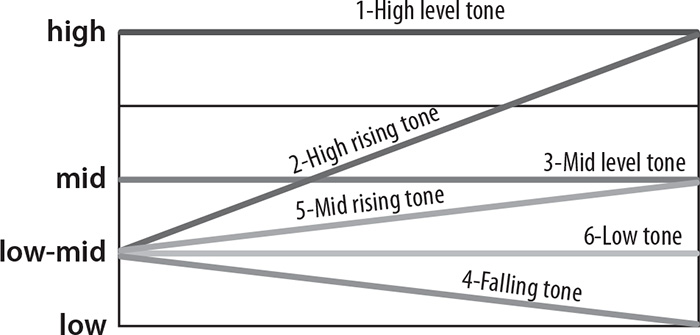 Tone 1 is a high-level tone represented by
Tone 1 is a high-level tone represented by  . Pronounce this in a higher note than your normal speech. Tone 2 is a rising tone represented by
. Pronounce this in a higher note than your normal speech. Tone 2 is a rising tone represented by  . Start off in a mid-low tone and then raise it to the high tone, as if you were asking a question.
. Start off in a mid-low tone and then raise it to the high tone, as if you were asking a question.
Tone 3 has no tone mark and you pronounce it as you would a normal English word, in the mid-tone. Tone 4 is a falling tone represented by  + h . Start off in a low-mid tone and drop your voice to the low tone. Tone 5 is a rising tone that starts at the same level as tone 2, but ends at mid-level rather than at the high tone. It is represented by
+ h . Start off in a low-mid tone and drop your voice to the low tone. Tone 5 is a rising tone that starts at the same level as tone 2, but ends at mid-level rather than at the high tone. It is represented by  + h. Tone 6 is similar to tone 1 and 3, except that it should be pronounced at a lower tone than tone 3, at the low-mid level.
+ h. Tone 6 is similar to tone 1 and 3, except that it should be pronounced at a lower tone than tone 3, at the low-mid level.
It is represented by no tone marking and h . Note: When learning new Cantonese words, it is a good idea to memorize both the word and its tone marking as one unit. The romanisation of a word, e.g., si , has several meanings depending on what tone it is pronounced at, so mispronouncing the tone could change the meaning from silk to time. For example,
| Word | Tone Number | Meaning |
| s | | silk |
| s | | history |
| si | | try |
| sh | | time |
| sh | | city |
| sih | | matter |
Basic grammar Cantonese grammar is quite simple. There are no verb conjugations, plurals, genders, or articles, and the word order is quite intuitive to English speakers. The following is an outline of Cantonese grammar using parts of speech that are familiar to English speakers.
Word Order More often than not, Cantonese word order is the same as in English: Subject Verb Object Ngh hohk Gwng Dng w I study Cantonese = I study Cantonese. Nouns and Pronouns Cantonese nouns are mostly made up of two characters. No distinction is made between singular and plural nouns. When you want to specify the number of items involved, use measure words. For example, the word for book sy can be either singular or plural unless it is necessary to indicate that there is more than one object. Thus,
| yt | bn | sy |
| one (measure word for books) book | = one book |
| luhng | bn | sy |
| two (measure word for books) books | = two books |
| sam | bn | sy |
| three (measure word for books) books | = three books |
In the above examples, the noun sy book is qualified by a number with the appropriate measure word bn to indicate its quantity, similar to how wed say one bottle of water or one sheet of paper in English.
Remember to use luhng a couple of instead of yih two when paired with a measure word. Like nouns, Cantonese personal pronouns do not change form when used as subjects or objects. Simple personal pronouns are: ngh = I/me, nih = you, kuih = he/him/she/her/it. However, Cantonese personal pronouns do have plural forms created by the addition of the suffix deih (plural).
Next page





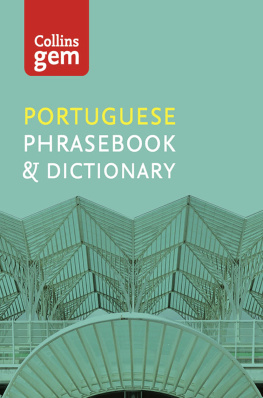

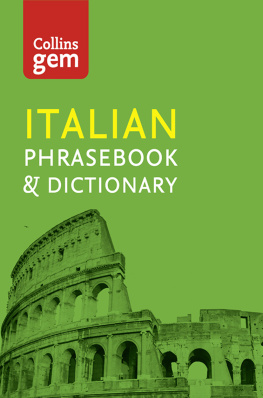


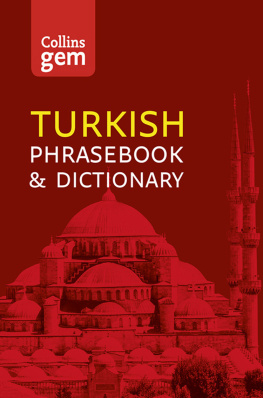
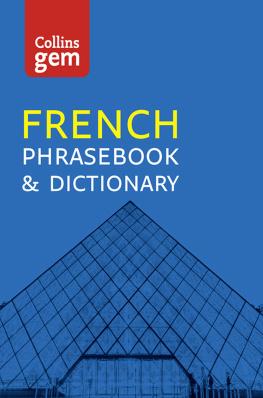


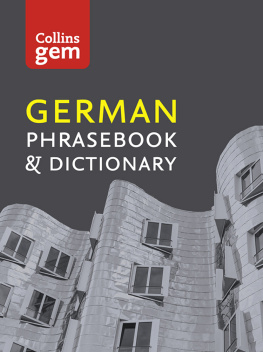
 Martha Tang
Martha Tang  Introduction Welcome to the Tuttle Essential Language series, covering all of the most popular Asian languages. These books are basic guides to communicating in the language. Theyre concise, accessible and easy to understand, and youll find them indispensable on your trip abroad to get you where you want to go, pay the right prices and do everything youre planning to do. Each guide is divided into 14 themed sections and starts with a pronunciation guide which explains the phonetic pronunciations of all the words and sentences youll need to know, and a basic grammar guide which will help you construct basic sentences in the language. At the end of this book is an extensive EnglishCantonese dictionary. Throughout the book youll come across boxes with a
Introduction Welcome to the Tuttle Essential Language series, covering all of the most popular Asian languages. These books are basic guides to communicating in the language. Theyre concise, accessible and easy to understand, and youll find them indispensable on your trip abroad to get you where you want to go, pay the right prices and do everything youre planning to do. Each guide is divided into 14 themed sections and starts with a pronunciation guide which explains the phonetic pronunciations of all the words and sentences youll need to know, and a basic grammar guide which will help you construct basic sentences in the language. At the end of this book is an extensive EnglishCantonese dictionary. Throughout the book youll come across boxes with a  beside them.
beside them. Tone 1 is a high-level tone represented by
Tone 1 is a high-level tone represented by  . Pronounce this in a higher note than your normal speech. Tone 2 is a rising tone represented by
. Pronounce this in a higher note than your normal speech. Tone 2 is a rising tone represented by  . Start off in a mid-low tone and then raise it to the high tone, as if you were asking a question.
. Start off in a mid-low tone and then raise it to the high tone, as if you were asking a question. + h . Start off in a low-mid tone and drop your voice to the low tone. Tone 5 is a rising tone that starts at the same level as tone 2, but ends at mid-level rather than at the high tone. It is represented by
+ h . Start off in a low-mid tone and drop your voice to the low tone. Tone 5 is a rising tone that starts at the same level as tone 2, but ends at mid-level rather than at the high tone. It is represented by  + h. Tone 6 is similar to tone 1 and 3, except that it should be pronounced at a lower tone than tone 3, at the low-mid level.
+ h. Tone 6 is similar to tone 1 and 3, except that it should be pronounced at a lower tone than tone 3, at the low-mid level.